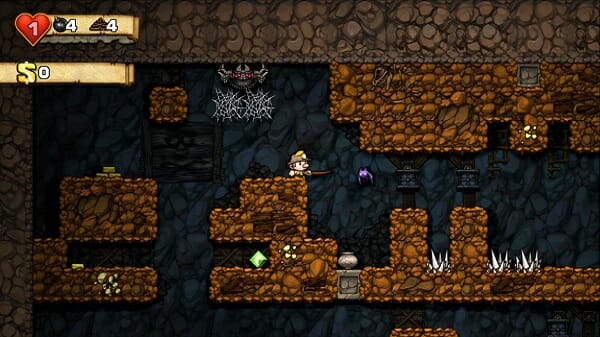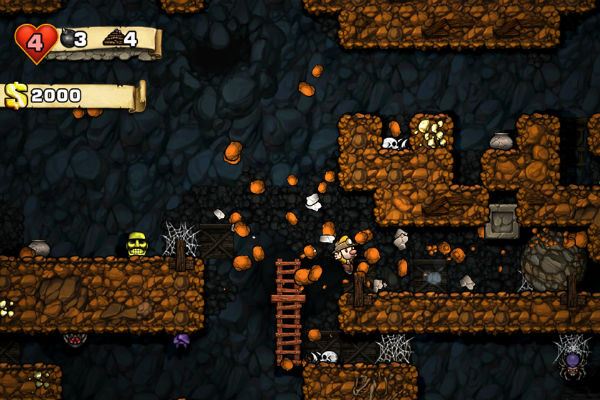
I was waiting on the fourth world. I’ve played enough Spelunky to write a review. I’d played enough Spelunky to write a review back in March, and not the original PC version, but the exact same 360 rendition that I’m discussing now. But I felt like I couldn’t write about Spelunky, or at least shouldn’t, until I finally experienced that fourth world. What mysteries does it hold? Earlier levels hit the jungle and ice quotas, so would the final one fill the obligatory lava slot on the old platformer menu? It wouldn’t be proper to write a review without knowing, would it?
Forget what’s proper. I haven’t seen the fourth world of Spelunky. I might never see that fourth world. But I can sure as hell write about Spelunky after a couple dozen hours of dying again and again in its ever-changing, always brutal world.
But what’s a Spelunky, anyway? It’s an old-school platformer (think Super Mario Bros.) with a pulp adventure / Indiana Jones aesthetic and a philosophy borrowed from the “roguelike” subgenre of role-playing games. Two crucial factors define a rogueline: dead means dead and the levels are randomly generated every time you play. You get one life with no savepoints, no persistance of power-ups and no idea what a level will look like before it starts. You can make it all the way to the very end of 4-4, die right before walking through that last door, and have to restart all over again from a different 1-1. It’s not a genre known for its politeness.
Forget that fourth world—Spelunky isn’t really about finishing. It’s about getting better. It’s about setting your own personal mark, either in the total value of gold and gems discovered, or how many levels you survived, and then besting that mark again and again. It’s about comparing your score to your friends and others through Xbox Live. It’s not about the end but about how well you do before you die. In that regard it’s more Donkey Kong than Super Mario. And that’s good, because if Spelunky was just a dickheaded version of Super Mario Bros. it would be a quickly forgotten curiosity (and if that’s all you’re looking for go play the original Japanese Super Mario Bros. 2).

That randomness keeps Spelunky from growing old. It also creates a system where mysterious new aspects of the game will continue to reveal themselves after hours and hours of play. I had reached the twenty-hour mark before learning that there are hidden levels packed full of treasure and shops with highly useful merchandise. I was on my twentieth transaction with a bald, mustachioed storekeeper before I realized I could send him into a murderous frenzy by accidentally bombing him. I don’t even want to remember how I learned that Kali would grant me an undisclosed blessing if I used the periodic blood-splattered altar to sacrifice the lost women (or, depending on how you change the game’s settings, men or adorable little pugs) I discovered whose rescue was the only consistent way to replenish health. (Once I switched over to pugs I could never make a sacrifice to Kali again.) Such secrets kept me playing, striving deeper and deeper into Spelunky’s frustrating caves in hopes of uncovering even more new twists.
These design decisions probably drive many people crazy. Instead they’re a sign of respect, for our patience, our temperament and our ability to succeed in an outrageously hostile environment. I still die easily on Spelunky’s very first level when I’m not cautious or thoughtful, and making it just to 2-1 feels like a genuine accomplishment, even though I’ve made it farther dozens of times now.
Spelunky recreates the sensation of arcade games, with the primacy of the leaderboard and simple rules buckling under brutal difficulty, but fragments the most crucial keys to success in Donkey Kong or Pac-Man into an almost infinite kaleidoscope. Somehow it does that effortlessly, with a design free of unnecessary embellishments. Spelunky’s randomness might seem to entirely dispatch of memorization and pattern recognition, but it merely multiples the instances in which both skills are needed far beyond the possibilities of early games. Memorize enemies and their motions, the slow descent of bats and remarkably fast pitch of boomerang-wielding aborigines, the peculiar nature of springboards and reaction times of yetis. The game expects you to call upon those memories with no advance warning. In that way it’s akin to a sports game—you learn the rules and the playbook and then how to adapt to always-changing circumstances. That makes Spelunky one of the few retro-flavored platformers of late to transcend its obvious inspirations. It’s a nostalgic treat that couldn’t exist during the era to which it pays tribute.
Spelunky was developed by Derek Yu and published by Mossmouth. Our review is based on the Xbox 360 version available through Xbox Live Arcade. An older version is available for the PC
Garrett Martin edits Paste’s games section and reviews games for the Boston Herald. From now through Tuesday he’ll spend most of his time obsessively checking Twitter for Atlanta Braves trade news.